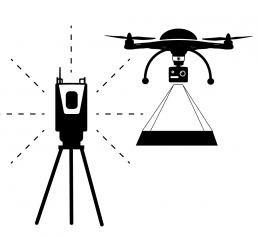Plate load test
We have several years of experience with plate load testing. The static plate load test is a reliable qualitative method for measuring the bearing capacity of unbound layers. Based on the analysis, clients and contractors get a quality check that the earthworks have been carried out according to the requirements of the project.
Static plate load test is a method that has been used for a long time in infrastructure construction such as roads, railways, airfields, and residential and industrial buildings. For roads, the unbound layers include, for example, sub-grade, sub-base or base-course layer. In the case of buildings, the plate load test is done on the layer on which the footing or concrete slab is built. The test is done at several points, and the results are compared to the requirements placed on the layer. If earthworks are done carelessly it may cause major financial consequences in the future.
To list a few, for example, facades can break, roads can become bumpy, and pipes can burst. The plate load test guarantees everyone involved in a project that the building will be on a solid foundation.The equipment we use consists of a circular steel plate with a diameter of 30cm. A jack is attached to the top of the steel plate. The test is done by placing the equipment under, for example, a heavy-duty vehicle or some type of excavator or roller. The surface on which the plate is placed should be as even as possible. If needed, it can be smoothed with a thin layer of fine sand. The jack is pumped up to achieve the desired weight (usually at least 6 tons) to load the surface under the plate. A device is connected to the plate from which the load and set values are read. Based on these values, deformation modules E1 and E2 are calculated. The unit for deformation modules is MN / m2. The density, meaning how tight the material is packed, is described by the ratio between E2 / E1. Reporting is done in pdf format and delivered to the client. In addition to the results, the report shows a map indicating in which parts of the construction site the tests have been made.• Bearing capacity test (Falling weight deflectometer).• A reliable method for measuring the bearing capacity of unbound layers.• This method has been used for a long time in infrastructure construction, for example in an inspection of the foundation of a house, sub-grade, sub-base or base-course layer.• The test ensures that building is on a solid foundation.• Reporting is delivered to the client pdf format. The report also includes a map, that shows where the tests have been made.
Do not hesitate to contact us if you have any questions about our measurement services. We will be delighted to tell you how we can facilitate your work!
Projects
The Länsiniitty Suburb of Vaasa, Finland | Machine control
The Länsiniitty suburb of Vaasa is located a stone's throw from the rapidly growing Kivihaka shopping mall. This area will be completed in spring 2018, and it consists of about 150 residential or…
Hotel Scandic Vaasa | Infrastructure measurement
In 2017, the Wasacon construction company built a hotel at the corner of Rautatienkatu and Rosteninkatu in Vaasa. The 8-storey triangular-shaped tower with glass facade adds something new to the…
Jarmo Toikka Ky | UAV Aerial Photography
In the summer of 2017, we conducted UAV flight measurements for Jarmo Toikka Ky, a company specialising in earthworks. The customer wanted to find out the number of gravel piles in an area spanning…
Malmberget | Gällivare | Mine measurement
The project has been about production measurements: mine drifts are marked where the drill rigs continue drilling according to pre-planned layouts. As the blasting progresses, the walls are surveyed…














